The newly signed deal between the International Potato Centre (CIP) and BlackPace Africa Group to advance potato production in Africa, including Rwanda, is a timely intervention that will help improve production, farmers have said. Commenting on the agreement that was signed last week, Jean Damascene Ntawushobora, the president of Irish Potato Farmers’ Union (IABINYA) in Nyabihu District, said farmers still need high yield varieties that are suitable for the different soil types across the country. “We are planting Irish potato varieties developed by former Agricultural Research Centre while others are imported from neighbouring countries such as Uganda and DR Congo. Therefore, any research and initiatives that focus on improving potato varieties is welcome,” he told The New Times in a telephone interview on Monday. More about the deal Last week, the International Potato Centre and BlackPace Africa Group signed a technical and scientific agreement to advance potato production in Africa. This inter-institutional framework collaboration agreement will further support development of both Irish and sweet potatoes in Africa, according to the deal signed in Kigali. “The objective of this agreement is to establish the basis for a technical and scientific collaboration between CIP and BlackPace Africa,” said Dr Hugo Campos, CIP director for research. It will enable the management and implementation of capacity building activities by both institutions through the exchange of information and knowledge, he added. “We are excited at this partnership with BlackPace Africa. Together, we look forward to improving the livelihoods of 136,000 smallholder households in Rwanda by use of high...
Farmers welcome new deal to boost potato production
Posted on: October 18, 2017
Posted on: October 18, 2017















